Here’s the October 2013 update for my Beat the Market Experiment, a series of three portfolios started on November 1st, 2012:
- $10,000 Passive Benchmark Portfolio that would serve as both a performance benchmark and an real-world, low-cost portfolio that would be easy to replicate and maintain for DIY investors.
- $10,000 Beat-the-Benchmark Speculative Portfolio that would simply represent the attempts of an “average guy” who is not a financial professional and gets his news from mainstream sources to get the best overall returns possible.
- $10,000 P2P Consumer Lending Speculative Portfolio – Split evenly between LendingClub and Prosper, this portfolio is designed to test out the alternative investment class of person-to-person loans. The goal is again to beat the benchmark by setting a target return of 8-10% net of defaults.
As requested, I updated the scale to zoom in on the comparison chart.
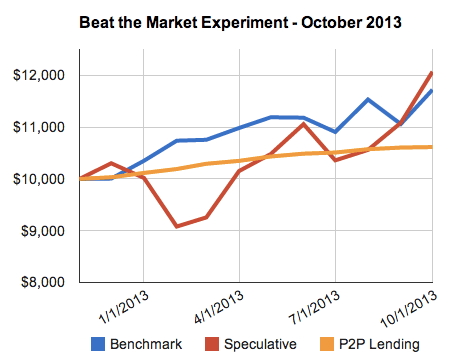
Summary. 11 months into this experiment, the Benchmark and Speculative portfolios are both up between 15-20%. The Speculative portfolio is actually winning now ($12,071 vs. $11,723). I sold all my AAPL shares in September. Both P2P portfolios continue to earn interest and are still on pace for an 8%+ annual return, but the growth rate has slowed lately as late loans have been taking a toll. Values given are after market close October 1, 2013.
$10,000 Benchmark Portfolio. I put $10,000 into index funds at TD Ameritrade due to their 100 commission-free ETF program that includes free trades on the most popular low-cost, index ETFs from Vanguard and iShares. With no minimum balance requirement, no maintenance fees, and no annual fees, I haven’t paid a single fee yet on this account. The portfolio was based loosely on a David Swensen model portfolio with a buy-hold-rebalance philosophy. Portfolio value is $11,723. Screenshot of holdings below:
$10,000 Speculative Portfolio. Many people speculate with their money, buying and selling stocks now and then, but they rarely track their performance even though they may brag about their winners. Honest, regular tracking is the primary reason for this “no-rules, just make money” account. I dropped $10,000 into a TradeKing account for this portfolio due to their low-cost $4.95 trade structure, free tax-management gain/loss software, and free dividend reinvestment.
I’m heavy in cash right now. After Apple announced their new iPhones, I sold all my shares. I think the company is fine, I’m just not optimistic about their share price in the short-term. My ENPH stock has basically doubled. Portfolio value is $12,071. Screenshot of holdings:
$10,000 Prosper and LendingClub Portfolio. For this one, I started with $10,000 split evenly between Prosper Lending and Lending Club, and went to work lending other people money and earning interest with an 8% target net return. Thus, this is also a race-within-a-race to see which of the two offers the best returns.
The LendingClub portfolio now has 223 current and active loans, 26 loans that were paid off early, and none in funding. I’ve stopped reinvesting in new loans as I may end this experiment soon. Two loans are between 1-30 days late. Four of the loans ($82) are between 31-120 days late, which I will assume to be unrecoverable. Two of the loans have been charged off ($48, one A-rated and one C-rated). ~$795 in uninvested cash. I will ignore accrued interest. Adjusted total is $5,322.
My Prosper portfolio now has 218 current and active loans, 30 loans that were paid off early, and the rest in funding. 8 loans are between 1-30 days late. Four are over 30 days late, which to be conservative I am going to write off completely (~$84 in remaining principal). Seven have been charged-off ($156, 4 A-rated, 3 C-rated). ~$588 in uninvested cash. Adjusted total is $5,294.
Here’s a chart just comparing the LendingClub and Prosper adjusted balances over these 11 months:
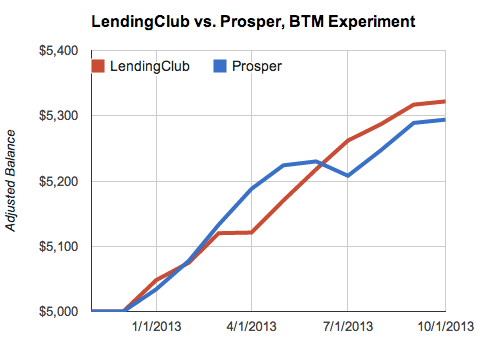
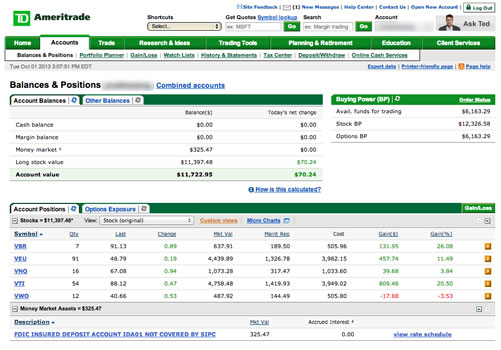
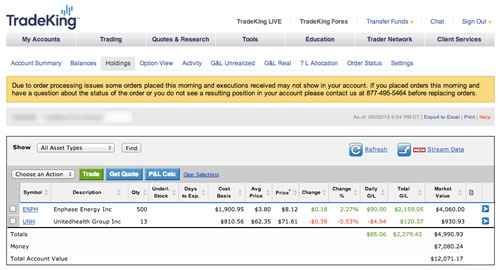
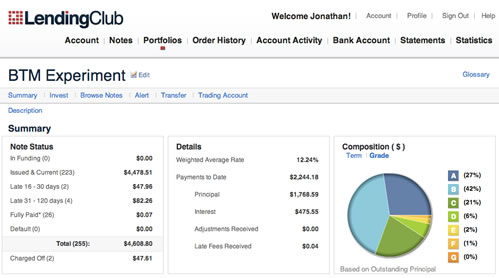
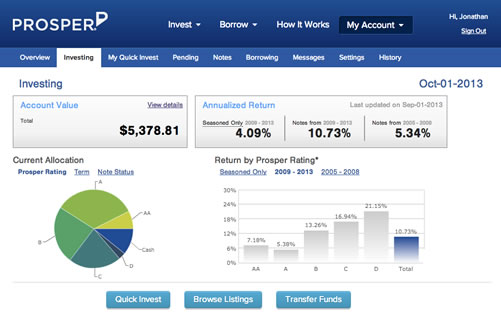
 The Best Credit Card Bonus Offers – 2025
The Best Credit Card Bonus Offers – 2025 Big List of Free Stocks from Brokerage Apps
Big List of Free Stocks from Brokerage Apps Best Interest Rates on Cash - 2025
Best Interest Rates on Cash - 2025 Free Credit Scores x 3 + Free Credit Monitoring
Free Credit Scores x 3 + Free Credit Monitoring Best No Fee 0% APR Balance Transfer Offers
Best No Fee 0% APR Balance Transfer Offers Little-Known Cellular Data Plans That Can Save Big Money
Little-Known Cellular Data Plans That Can Save Big Money How To Haggle Your Cable or Direct TV Bill
How To Haggle Your Cable or Direct TV Bill Big List of Free Consumer Data Reports (Credit, Rent, Work)
Big List of Free Consumer Data Reports (Credit, Rent, Work)
I have used Prosper in the past, they tended to have a lot of defaults on their loans regardless of grade, so I gave up on the peer to peer. If I was to try it again I wouldn’t do Prosper again, though might try LendingClub, seems like in general their have their stuff together more.
Johnathan,
Your P2P captures a difficult to invest part of the bond (debt) market.
Can you graph your P2P results vs high-yield (VWEHX) as bench mark? What’s the rolling correlation? (granted, it’s a short time span)
How do you think the P2P crediting ratings compare to the credit rating used for the general bond markets (e.g. S&P)?
Thanks,
John
@Dan – LendingClub tends to be more strict with underwriting, while Prosper is still riskier but usually with higher interest rates.
@John – Have you seen my previous post on Prosper/LendingClub vs. High Yield Bonds?
https://www.mymoneyblog.com/lendingclub-prosper-vs-junk-bonds.html